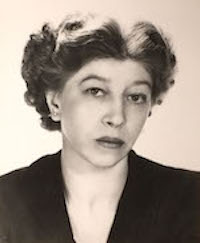It’s been 40 years since the death of The Poynter Institute’s founder, Nelson Poynter. It’s been 50 years since the death of a different, but equally significant, Poynter — Henrietta.
Henrietta Malkiel Poynter was Nelson Poynter’s second wife and journalistic partner. Together, they co-founded the Congressional Quarterly (CQ), shared a byline in a weekly column at the St. Petersburg Times and promoted the crucial idea that independent journalism is essential to improving democracy.
Mr. Poynter credited Henrietta, also an associate editor, vice president and trustee at the St. Petersburg Times, with the success of CQ as the first journalistic accounting of congressional activity and was quick to brag about her. He wrote before their wedding, “It would take pages for me to expand upon her virtues. All I can say is that I know this will be the most successful marriage in history.”
Prior to meeting Mr. Poynter, Henrietta was one of the first graduates of the Columbia Journalism School, worked as a features editor for Vanity Fair and foreign editor for Vogue in Europe, and helped establish Voice of America during WWII.
When Henrietta died suddenly at the age of 66, Nelson mourned deeply. “Her passing marked the end of an era for Mr. Poynter,” said David Shedden, former research librarian at The Poynter Institute. “He started looking to the future and thinking about his legacy. He focused on creating a school for journalists, which of course became the Modern Media Institute, and then the Poynter Institute.”
Nelson later married Marion Knauss.
The New York Times published Henrietta’s obituary in 1968, commending her 45-year journalism career and highlighting her critical work with CQ. A year later, the Florida Legislature passed a resolution crediting her with “being renowned the world over as an innovator in the fields of mass communication.”
1969 is basically where the acknowledgments stop.
Let’s remove her from Nelson’s shadow and shine a light on her legacy.
Born ready
Henrietta Malkiel was born in New York in 1901 to Russian Jewish immigrants who modeled the love-partnership she would one day have with Nelson. Her father, Leon, was a lawyer-politician, and her mother, Theresa, was a women’s rights and labor activist. Together, they founded the Socialist Party newspaper, the New York Daily Call.
Like Henrietta, Theresa also saw success independent of her husband. While Henrietta was growing up as an only child, her mother toured the country speaking on behalf of women’s suffrage. She was inspired by the Triangle shirtwaist factory fire, which killed more than 140 women and girls in a New York City garment factory, to write “The Diary of a Shirtwaist Striker.” The novel was cited as a major factor in reforming New York state factory laws.
Her parents’ interest in politics, social justice and the power of the written word to better government oriented Henrietta toward her career in journalism.
Interested in learning more about strong women in journalism? Subscribe to The Cohort, Poynter’s email newsletter for women kicking ass in digital media.
Arts journalism in the Jazz Age
Henrietta graduated from Columbia Journalism School when it was still an undergraduate program in 1922. During the 1920s and early 1930s, Henrietta was a features editor, arts radio commentator and literary agent in New York, Paris and Hollywood. Writing and editing for Vogue and Vanity Fair, she got to know the big names in theater, literature and music. She intellectually sparred with people like Charles Lindbergh at glamorous salons and was close friends with the Gershwins. Henrietta recalled “making the tour, with George Gershwin, through all the shops of the Boulevards, to find the right French taxi horn, for ‘An American in Paris.’”
“So she launched into the chic arts milieu of arts journalism,” wrote Robert Pierce in “A Sacred Trust: Nelson Poynter and the St. Petersburg Times.” She shipped “out to Europe at the same time Nelson was starting his world trip.” Her early work abroad led to a lifetime of world travel.
Love and war

Nelson and Henrietta met, fittingly, on the job. During WWII, they both worked for Roosevelt’s 1940 reelection campaign and later for projects at The United States Office of War Information (OWI). Nelson and his first wife Catherine divorced in early 1942.
Of their new partnership, Nelson wrote to his mother, “You will never find two happier people in the world than Henrietta and I,” and he described her as “this wonderful girl who up to now has found ideas, work and geography more interesting than marriage.”
“They were soulmates,” said David Shedden. “She was a journalist. Mr. Nelson loved journalism. The fact that they shared ideas on the world and eventually shared a byline — it was hard to know where he stopped and she began.”
She did begin Voice of America. Henrietta was the assistant program chief for OWI, and is credited for coming up with the name “Voice of America” during a brainstorming session with Jack Houseman and others a few weeks after Pearl Harbor.
Henrietta’s lasting legacy
After the war, the Poynters moved back to St. Petersburg and Washington, D.C. It was working for the regional newspaper that Henrietta grew increasingly frustrated with the difficulty of reporting on Washington.
“We became convinced that if newspapers were to survive, they had to provide substance and background, perspective and facts, for an increasingly complicated world,” wrote Henrietta. “We had discovered, in trying to research our own stories, that despite hundreds of Washington sources, it was impossible to follow the multiple activities of the Congress. Individual voting records were not available and we had to plow through millions of words of hearings and debate, and hire professional researchers to find out what was really going on. No measure existed to define Party Unity, a Congressman’s support of the President, or even absenteeism. So we started the Congressional Quarterly.”
The CQ weekly report, founded by Nelson and Henrietta in 1945, served newspapers around the country as a source and record for everything going on at Capitol Hill.
This new kind of publication was a cross between journalism and reference work. Newspapers saved CQ in binders and paid a lot of money at the time to receive its exceptionally precise, detailed reporting.
“Among those who follow congressional action and news, CQ was the bible,” said Poynter president and former CQ managing editor Neil Brown. “And if you’re writing for the bible, you better get it right.”
In the first 10 years, the publication struggled financially. Nelson focused on building up the St. Petersburg Times, while Henrietta spent at least half her time in Washington translating her encyclopedic knowledge of Congress into the weekly editions of CQ. Her focus, passion and dedication convinced Nelson to maintain the business until it became sustainable.
CQ was a precursor to C-SPAN, and its example led to modern political and accountability journalism — in places like The Poynter Institute’s Pulitzer Prize-winning PolitiFact.
“For a childless couple, Congressional Quarterly was clearly the favorite offspring of Nelson and Henrietta Poynter,” wrote researcher Jean Chance. Henrietta’s baby lives on today as part of The Economist Group’s CQ Roll Call.
Though they — and we — should give her more credit for it.
Special thanks to the research of Jean Chance and conversations with David Shedden, Roy Peter Clark, Bob Haiman, Rick Edmonds and Neil Brown for illuminating Henrietta’s legacy.







